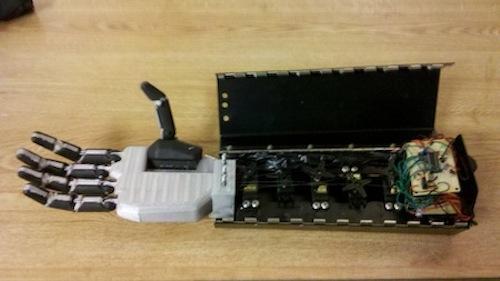Force-Controlled Finishing Adds Human Touch
March 31, 2014

Many dimension-driven manufacturing processes require force-controlled blending or finishing operations. These operations are normally performed by human operators because the human touch provides the compliance that is essential for these operations but is lacking in rigid position-based machine tools. But these manual finishing operations are usually strenuous, repetitive, and prone to injury, so manufacturers are looking into automating them with compliant end-of-arm robotic tooling that can hold a tool with a constant pressure against the workpiece.
Compliant robotic tooling usually requires a motor to drive a deburring, grinding, or polishing tool. It is essential to minimize the weight of the end-of-arm tooling in order to provide the quick dynamic robotic response needed to achieve high productivity and quality. PushCorp Inc. further increased the performance of their servo-driven, end-of-arm tooling product lines by using new Kollmorgen liquid-cooled frameless servomotors that deliver up to 5-HP in a package about the size of a can of soup. This high level of power density enables building tooling that can deliver the performance demanded by industrial users to improve operator safety, productivity, and quality.

Force-compliant finishing
Parts are typically brought to a net dimensional shape by machining, casting, forging, molding, and similar manufacturing processes. These parts often meet specifications but require additional processing to achieve the required surface finish. Tool marks and scallops need to be removed from machined parts. Parts produced by injection molding, casting, and forging require the removal of flashing, gates, and parting lines. These finishing operations require a force-controlled process, a type of compliance not offered by rigid, position-based machine tools, so they are nearly always performed by operators holding power-driven tooling and using the human touch to provide just the right amount of force.
But the weight of the tooling and the need to maneuver into nooks and crannies to fully finish the part makes these operations very difficult for a human operator. For example, a supplier of cast aluminum automotive wheels previously had several hundred workers manually polishing the wheels using power sanders. The company experienced worker injuries, high turnover, low productivity, high training costs, and quality issues.
The leading solution to automate these operations uses the robot arm for positioning and motion control and the end-of-arm tooling to provide the compliance needed for automated surface finishing. Mounting the force control device to the robot wrist requires special consideration due to the changing axis of compliance. The weight of tooling, media, and carriage always acts in a vertical direction downward while the compliance axis of motion, on the other hand, continuously changes as the robot moves through space.
The actuator force must be increased or reduced depending on the direction in which gravitational force is acting relative to the compliance axis. Active force control uses a standalone controller to manage a closed-loop system and correct for any errors based on input from a load cell that continuously monitors the applied force. An accelerometer tracks the orientation angle of the compliance axis of compliance so that corrections can be made for the effects of gravity.
Power-dense motor designs
PushCorp is a leader in the field of developing custom force-compliant, end-of-arm tooling for a wide range of blending and finishing applications. This tooling demands very power-dense motor designs because the performance of the robot depends on the size and weight of the end-of-arm tooling. The systems use frameless direct-drive rotary systems comprised of a separate rotor and stator without bearings, housings, or feedback devices. These components are intended as a kit to be designed into and become a direct part of the company's tools. The system operates as a closed-loop servo with the load cell and accelerometer designed into the tooling. An electronic drive amplifier runs the motor and manages the feedback device.
About the Author(s)
You May Also Like





